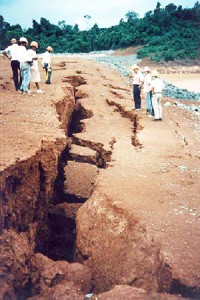Mount Polley spill blamed on design of embankment
Independent investigation finds foundation of earthen dam failed because of unstable underlying layers
CBC News Posted: Jan 30, 2015 5:56 AM PT Last Updated: Jan 30, 2015 12:32 PM PT

An earthen dam containing the Mount Polley mine tailings pond gave way early on the morning of Aug. 4, discharging 25 million cubic metres of contaminated water and mining waste into creeks and rivers near the town of Likely, B.C. (Ministry of the Environment)
An independent investigation has determined the breach of the Mount Polley mine tailings dam in B.C. was caused by a failure to detect a weak layer in its foundation, likening the massive embankment to a "loaded gun."
The report, which was released on Friday morning in Victoria, said the design failed to take into account the complexity of the instability of underlying glacial and pre-glacial layers under the retaining wall.
But the authors, geotechnicians Norbert Morganstern and Steve Vick, did not blame provincial inspectors for not detecting the problem beforehand.
The investigators said the dam was built on a weak layer of glacial deposits that was undetected at the time, making the dam like a 'loaded gun."
They said the construction of a steep slope in the embankment as the dam was raised was "like pulling the trigger," causing the failure last summer.
They also concluded that massive volume of water in the tailings dam did not cause the dam to fail, but it did result in more tailings being released when it did breach.
Just eight days before the dam failed, a plan was approved to raise the dam further, but on the condition that a buttressing wall was put in place and the slope decreased, they said.
The investigators also made several recommendations to improve the safety of tailings dams, including updating the way they are designed, monitored and regulated in B.C.
Minister reacts to report
B.C.'s Minister of Energy and Mines Bill Bennett said he was thankful the panel was able to narrow down the failure to a specific cause.
"I am relieved that we have a cause," said Bennett. "Now that it has been identified, we can move forward."

B.C.'s Minister of Energy and Mines Bill Bennett says the government will take action to prevent future tailings dam failures. (CBC)
Bennett said the government would take action based on the report, including the inspection of about 100 existing tailings dams for similar risks, the establishment of review boards for existing dams and a core review of existing regulations.
"There should be zero failures of this nature.… Everything must be done to ensure this does not happen again."
"This was a spectacularly horrible failure and it is one of a kind," said Bennett.
Bennett said there are still two other reports due later this year that will examine the failure of the dam.
One report by the chief inspector of mines, which is due in June, would identify those responsible for any mistakes made, said Bennett.
The other report would be coming from the Ministry of Environment's Conservation Officer Service.
Dam failed in August
When the dam at the Mount Polley tailings pond breached last August, it released 25 million cubic metres of contaminated water and mining waste, contaminating lakes, creeks and rivers near the town of Likely in the B.C. Interior.
The spill also raised questions about the inspection process for mines in the province. NDP Leader John Horgan has previously claimed a report from four years ago that detected a crack in the dam was hidden away.

Investigators say the dam was built on a weak layer of glacial deposits that had been undetected.








